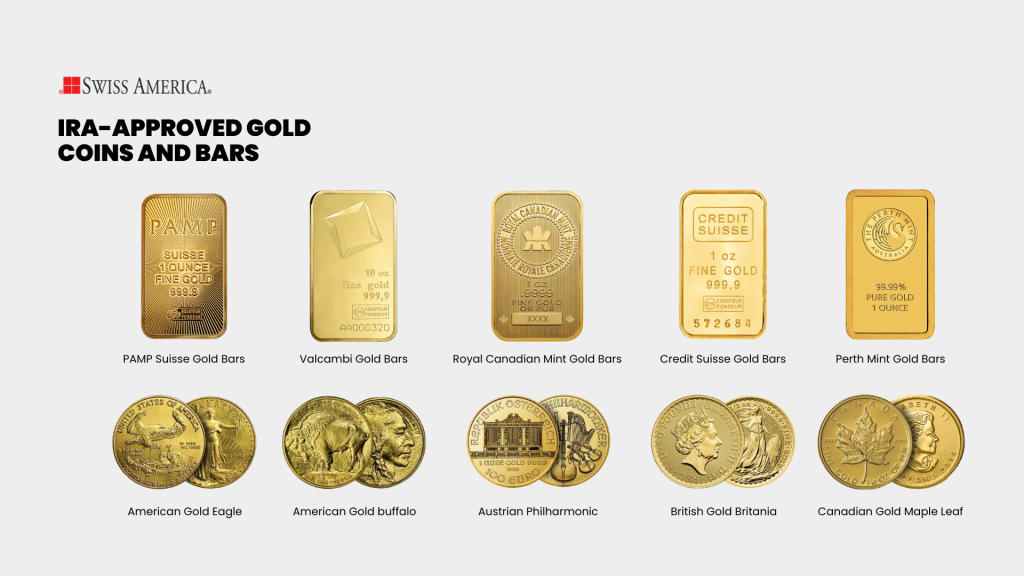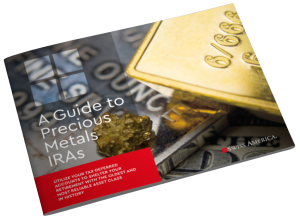
Gold has been reaching record highs in the past year. It’s the asset investors’ turn to for inflation protection and portfolio diversification. If you’re considering buying gold for retirement savings, this article covers options, strategies, and how to get started today.
Why invest in gold?
Gold is the ultimate defensive asset. It gives you a way to reduce risk and protect your wealth from the effects of inflation and depreciation of the US dollar. Gold also has a history of low correlation with traditional assets like stocks and bonds. This independence gives it a better chance to hold value when the economy turns uncertain. It’s one reason we’re seeing record highs right now.
It’s also why keeping 5-15% of your retirement portfolio in gold can provide stability and resilience during economic downturns. Some investment advisors, like Ray Dalio, point to gold as a strong protection strategy. At the Greenwich Economic Forum, he recently stated:
“If you look at it just from a strategic asset-allocation perspective, you would probably have something like 15% of your portfolio in gold, because it is one asset that does very well when the typical parts of the portfolio go down”.
Benefits of adding gold to your retirement savings
Gold’s resilience makes it a key investment for retirement portfolios. As you plan for your golden years, adding precious metals to your strategy provides risk Hey Johanna are you there Hello Can’t hear you I do have an update I did talk with a banker Hey there protection.
Key benefits of gold in your retirement portfolio:
- Inflation protection: Gold historically outpaces inflation rates to help protect your purchasing power over time.
- Portfolio diversification: Precious metals usually move independently from traditional investments like stocks, mutual funds, and bonds to help reduce overall portfolio risk.
- Crisis insurance: During economic downturns, geopolitical tensions, or currency devaluations, gold provides stability when you need it most.
- Tangible asset ownership: Physical gold gives you direct ownership of a real, lasting asset.
You’ll usually hear experts recommend that you allocate a portion of your retirement portfolio to precious metals. This approach has been effective during every major economic crisis, from the 2008 financial meltdown to the recent high inflation rates we’ve seen since 2022.
Risks and limitations of gold investments
Like all investments, there are some trade-offs for gold investing to consider:
- No income generation: Gold and other precious metals don’t pay interest, dividends, or yield. It only appreciates if the market price rises, so your returns depend entirely on changes in price.
- Short-term volatility: Gold holds value over the long term, but it can change greatly in the short run. Drops in price happen when investors move into income-producing assets.
- Storage and insurance costs: Owning physical gold means you’ll have extra costs for secure storage, insurance, and custodian fees if you use a Gold IRA.
- Opportunity cost: Holding too much gold can mean missing out on higher returns elsewhere with other investment types like stocks or real estate.
Ways to invest in gold
If you’re looking at adding gold to your retirement portfolio, there are three primary investment options:
Physical gold bars or coins
You can buy gold coins or bars that you store at home, in a bank safe deposit box, or in a depository.
Pros: Physical gold gives you direct ownership and independence from the financial system. It’s one of the few assets that can’t go bankrupt or be wiped out by market crashes.
Cons: Storing and insuring it costs more than holding paper gold, and it’s not as liquid. When you sell, you may notice a small spread between the dealer’s buy and sell prices.
Gold ETFs
Gold exchange-traded funds give you a share of gold stored elsewhere.
Pros: These types of gold investments trade like regular stocks, giving you quick access and flexibility. You don’t need to deal with storage, insurance, or shipping. Fees also tend to be lower than owning gold bars or coins.
Cons: The tradeoff is that you don’t actually own physical gold. Your investment relies on the fund or institution behind it, which brings an extra layer of risk.
Gold stocks
You can also buy shares in gold mining companies to get exposure to the gold market.
Pros: Gold mining stocks can offer higher potential returns because when gold prices rise, the profits of mining companies may grow even faster. They’re also easy to buy and sell on the stock market, giving you strong liquidity.
Cons: The downside is that you’re betting on how well a company runs, not just on the gold price. Operational problems or market downturns can hit these stocks harder, making them more volatile than owning physical gold.
Here’s a quick summary of the different ways you can hold gold for preserving wealth:
| Type | Pros | Cons |
|---|---|---|
| Physical gold | Direct ownership that’s independent of financial system | Storage and insurance costs |
| Gold ETFs | Easy to trade on stock exchanges | No physical ownership and counterparty risk |
| Gold mining stocks | Potentially high returns | Company risk and higher volatility |
Physical Gold IRAs
For retirement, you can invest in physical gold using a Gold IRA. In 2025, about 21% of our customers chose this option. This self-directed individual retirement account lets you hold physical gold and other IRA-approved precious metals instead of traditional paper assets. It follows the same structure and tax rules as a traditional or Roth IRA.
To fund your Gold IRA, you can roll over existing retirement accounts like an IRA, 401(k), 403(b), and TSP. You can also add new contributions each year. For 2026, contribution limits are $7,500 annually if you’re under 50, or $8,600 if you’re 50 and older.
The Internal Revenue Service (IRS) has strict requirements for Gold IRA investments. This includes approved precious metals and storing your metals.
Approved precious metals
IRS rules for which gold or other metals you can buy include:
- Purity: Gold must be at least 99.5% pure, silver 99.9%, and platinum or palladium 99.95% or higher.
- Source: All metals must come from an IRS-approved mint or refiner. Common examples include the U.S. Mint, Royal Canadian Mint, PAMP Suisse, and Valcambi.
- Form: Only specific bullion coins and bars qualify. Examples include the American Gold Eagles, Canadian Maple Leafs, and Austrian Philharmonics. Collectible or numismatic coins aren’t eligible.

Storing your precious metals
With a precious metals IRA, you can’t store your gold at home. You’ll need to keep them in an IRS-approved depository instead. These facilities provide insurance and secure storage for your metals until you’re ready to withdraw at retirement age.
Steps to set up a Gold IRA
Here are the steps to set up a Gold IRA:
- Choose a qualified custodian who specializes in self-directed IRAs and precious metals. Their role is to handle all transactions and verify compliance with IRS regulations.
- Fund your account through direct contributions, transfers, or rollovers from existing retirement accounts.
- Buy approved gold products like American Gold Eagles and Canadian Maple Leaf coins or bars from PAMP Suisse or Valcambi.
- Begin storing physical gold at an IRS-approved depository facility.
Choosing a precious metals dealer
Here’s what to look for in a precious metals dealer for your Gold IRA:
- Work with an experienced national dealer: Buy from a recognized national dealer with at least ten years in business. This means they’ve seen every kind of market cycle and can help you navigate it. Check their references, read reviews, and ask plenty of questions.
- Confirm availability and pricing: Make sure the coins or bars you want are available at the quoted price and that you can receive them quickly. If the dealer tells you something is unavailable, look elsewhere. A reliable dealer stands behind their prices and inventory.
- Choose a dealer that offers a two-way market: A reputable dealer sells and also buys back gold. This gives you liquidity when you’re ready to sell and shows the dealer’s confidence in what they sell.
- Expect quick settlement and delivery: Dealers should complete trades within about 72 hours and deliver your order within two weeks. Anything longer than that can be a red flag.
- Make sure they disclose all risks: A good dealer explains both the upside and the downside of any investment. Gold has advantages, but every investment carries risk, and your dealer should be upfront about that before you buy.
Maximizing gold tax efficiency
A Gold IRA gives you the same tax benefits as a traditional IRA. Here’s how to maximize tax efficiency:
IRA vs. taxable gold investments
Gold IRAs are tax-advantaged accounts to help you save for retirement:
- Traditional Gold IRA: You fund a traditional Gold IRA with pre-tax dollars, which gives you immediate tax savings. And then, your investments are tax-deferred until withdrawal.
- Roth Gold IRAs: These accounts use after-tax dollars to give you tax-free growth and withdrawals in retirement.
An IRA also helps you avoid capital gains taxes, which can be as high as 28% on gold or other physical precious metals, because the IRS considers these collectibles.
Required minimum distributions
If you have a traditional Gold IRA, the IRS requires you to take required minimum distributions (RMDs) at age 73. If you have a Roth IRA, you won’t have RMDs during your lifetime.
The biggest thing here is to plan for it, to watch what’s happening with gold prices, and to see when is the best time to sell.
Investment portfolio allocation
Financial experts recommend allocating 5-10% of retirement portfolios to gold for most investors. If you’re a conservative investor with a lower risk tolerance, you may go as high as 15%. This provides inflation protection without overexposure to volatility.
Rebalance annually to stay within your target allocation. Watch gold prices and make sure you have enough liquidity in your other investments so you’re not forced to sell gold to cover expenses.
Professional guidance
Gold investing has its own tax rules, so it pays to get expert advice. A financial advisor or tax professional can show you how to structure your gold investments to stay compliant and make the most of your retirement plan.
Final thoughts on buying gold for retirement
Gold’s performance so far in 2025 reminds investors why it’s such an important part of a retirement portfolio. It’s one of the few assets that can hold its ground during uncertainty, helping protect your purchasing power when inflation rises or markets get shaky.
Most investors keep somewhere between 5% and 15% of their retirement savings in gold. That range gives you strong protection without putting too much of your portfolio in one place.
If you decide to open a Gold IRA, follow the IRS rules and work only with trusted custodians and experienced dealers like Swiss America. To learn more about investing in gold, connect with the Swiss America team today!
Buying gold for retirement: FAQs
Should I invest in gold and silver as a retirement goal?
Gold and silver can be a smart part of your retirement plan because they help balance out other investment volatility and keep your money in tangible assets.
Is buying gold the smartest move in 2026?
The price of gold is up over 50% as of this writing because of central bank purchases, inflation, and a weakening U.S. dollar. It can be a smart move as part of a balanced portfolio.
What is the downside of buying gold?
The biggest downside is that gold doesn’t generate income so you’re giving up the opportunity to hold higher-yield assets. This is why it’s a part of an overall diversified portfolio.
The information in this post is for informational purposes only and should not be considered tax or legal advice. Please consult with your own tax professionals before making any decisions or taking action based on this information.
